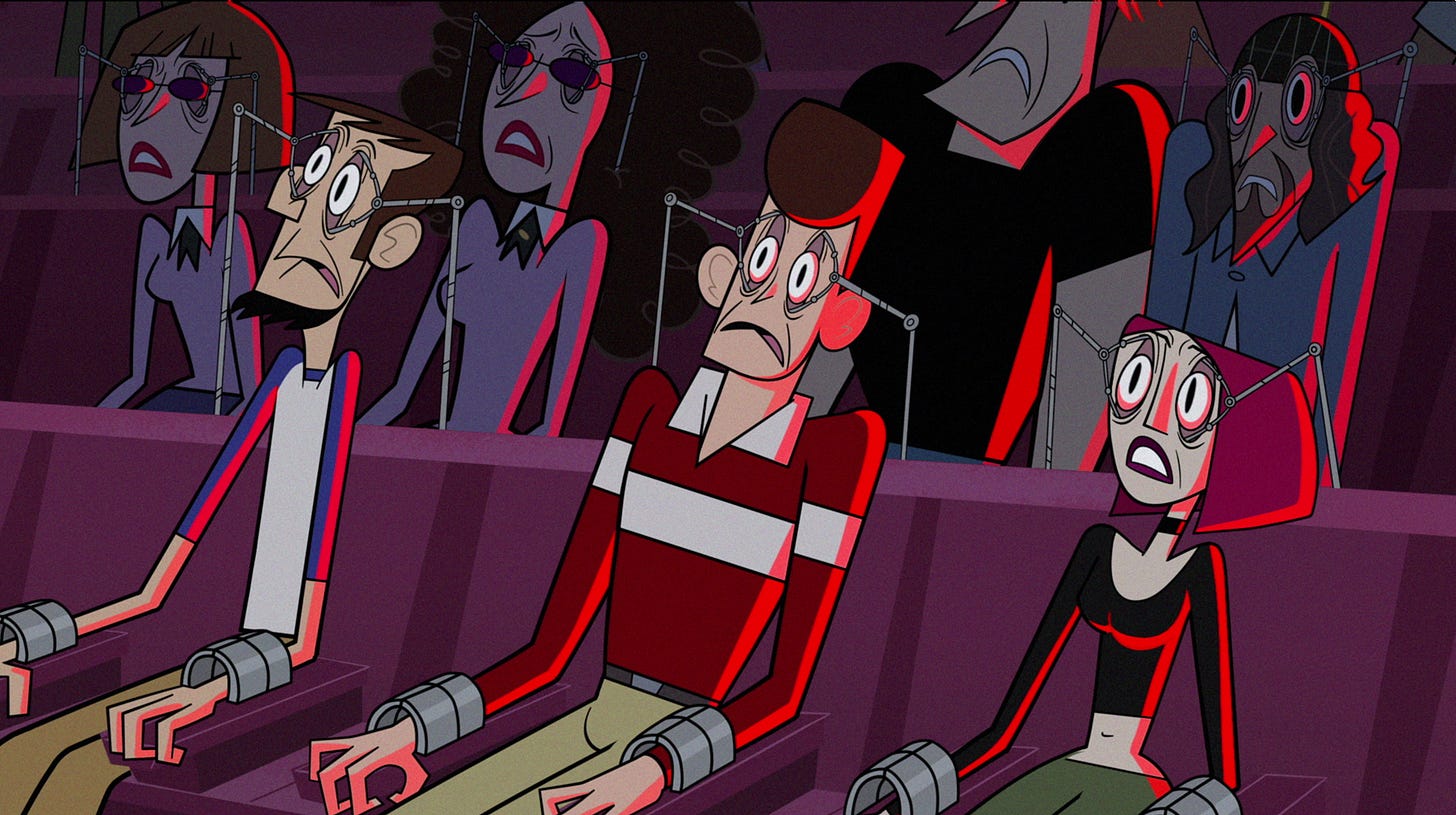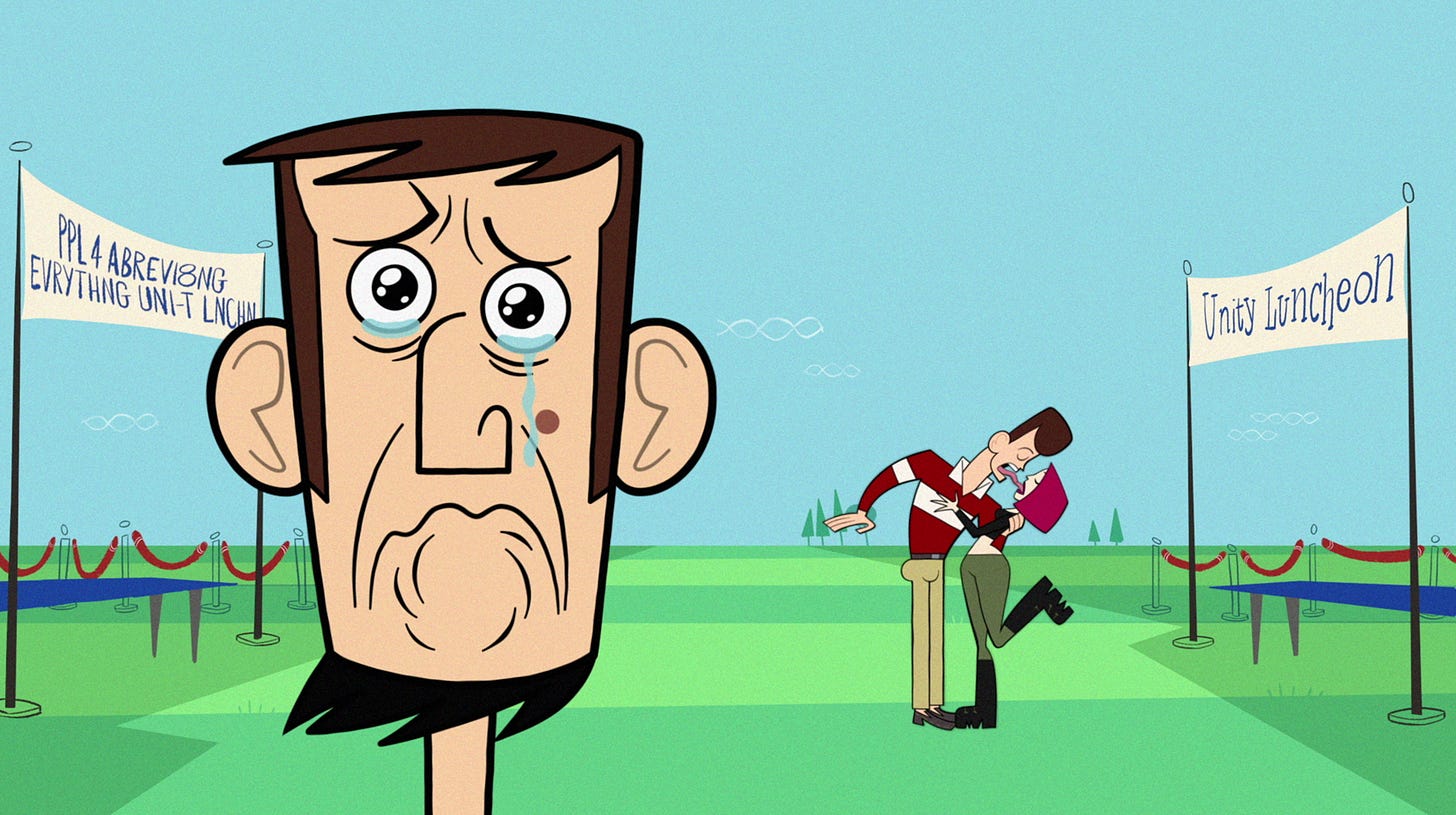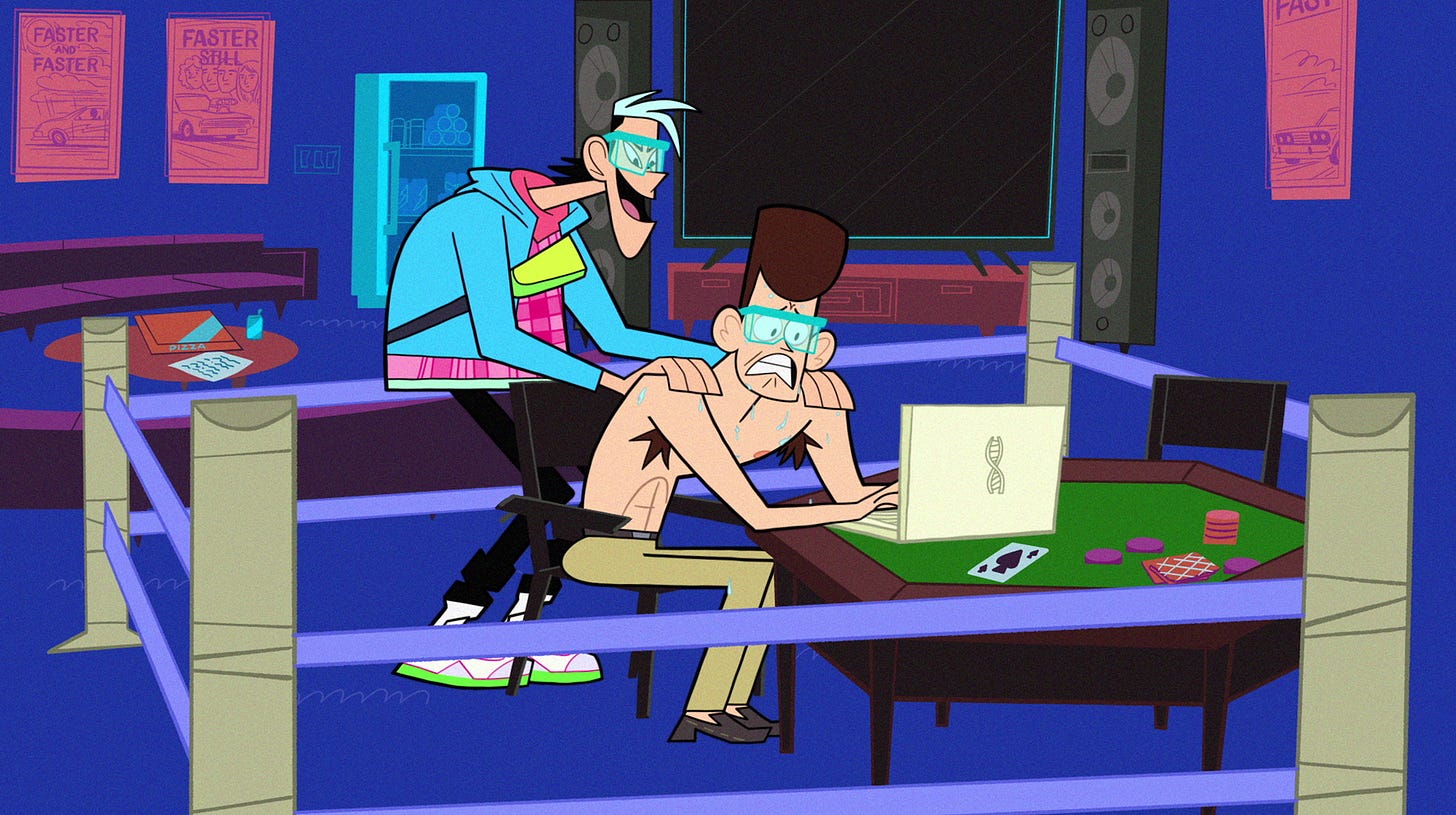Review: Clone High, "Let's Try This Again" & "Sleepover" | Season 1, Episodes 1 & 2
The long-awaited, mildly anticipated cult hit unthaws to rethink its (still absurd) reality
Welcome to Episodic Medium’s weekly coverage of Clone High, which debuts on Max today before returning on June 1. As always, the first review is available to all, but subsequent reviews will only be available to paid subscribers. You can check out our full Summer schedule here, and learn more about the site and its mission on our About page.
It would be absurd to suggest that Clone High ever took itself seriously. When the animated comedy debuted back in 2002, it was the very definition of irreverence, throwing spaghetti [videos] at the wall in service of a ludicrous premise and the teen drama they layered into it.
And so when I say that [HBO] Max’s unthawing of the series takes the act of returning to this world and its characters seriously, I’m not implying that the tone of the show itself has changed. This is still a show where Frida Kahlo’s unibrow is sentient, and where a sleepover seance awakens a bloody demon who joins the girls for the rest of their festivities. However, in updating the show two decades later, creators Phil Lord and Chris Miller teamed with Erica Rivinoja—a staff writer on the original series, and a co-writer on their Cloudy with a Chance of Meatballs 2—to treat the idea of bringing back the show as a complex cultural project. It’s not as simple as keeping the controversial depiction of Gandhi frozen in the meat locker or casting an Iranian-American actress to take over the role of Cleopatra. The new Clone High is defined by its consciousness to the reassessment of huge parts of culture and society that has happened in the past two decades.
I’ve written a bit about the semantics of returning series like this one, often referred to as “reboots” or “revivals,” but I think the best way to ultimately understand Clone High is as a “rethink” for how it blends the two approaches. It’s a revival in the sense that it literally unfroze (most of) its characters and even updates the audience (and the shadowy government figures responsible for thawing them) on the central love rhombus in case they’re among those who missed the cult show the first time around. It’s a reboot given that Scudworth has been secretly operating a new version of the program in secret, such that a new group of clones are sexy teens now, and they’re also going to make it if they try alongside the originals. And it’s a rethink because how it approaches both of these shows is fundamentally informed by the passage of time in between, at least through two episodes.
The very title of “Let’s Try This Again” points to the reiterative element of the new series’ premise, focused on establishing a new social order for our characters to navigate. The result by necessity sort of flattens the returning characters, but in ways that capture their essence in dynamic ways. A lot has changed in 20 years, and while we don’t see all of Scudworth’s “We Didn’t Start The Fire” riff, we lived enough of it to have a clear idea of how the four returning characters would find this new world challenging.
Or, rather, I thought I had a clear idea. Joan and Cleo—the latter now voiced by Mitra Jouhari, and the most sidelined of the returning characters in these first two episodes—fit into this new social order as I’d expect: whereas Joan is suddenly elevated in popularity in an environment where rigid social structures set by beauty and popularity are increasingly upended by pushes for inclusivity, Cleo finds herself being treated as “normal,” which is pretty much the end of her entire world. The zoom-ins on Frida’s unibrow and mustache are silly, but they’re also an efficient distillation of the shifts in the social order, and the Unity Week’s emphasis on inclusivity reinforces how the mechanisms of popularity have naturally shifted toward a different archetype than the one teen shows of the early 2000s naturally gravitated to. And so while Joan was surprised to find that she’s considered to be hip and cool in this new climate, I wasn’t, as the role reversal between those two is a natural way to address how the 2023 of it all would reshape their place in the world.
My favorite thing about “Let’s Try This Again,” though, is how these roles are reversed for the male characters. Despite embodying toxic masculinity in the original series, JFK’s insatiable libido is received as sex positivity, whereas Abe’s neuroses have him fumbling his way into every possible pitfall of being frozen for twenty years. The R-Word, gay meaning bad, referring to sitting “Indian Style”—Abe does it all, and becomes the show’s window into the cycles of cancel culture as he rages his way through a failed apology video on FlipFlop. It’s the opposite of what you might expect at first, but you quickly realize that it’s less about who is more toxic (JFK, by a hair) and more which one of them would be more likely to be perceived as toxic based on how they function in the world.1 JFK’s effortless confidence pastes over the “frozen for twenty years” situation way faster than Abe’s insecurity, so it’s only fitting the latter would be the one tagged as a mansplainer by Topher Bus despite JFK being the only who tried to mansplain mansplaining.
“Sleepover” somewhat reverses these roles, though, after the dust has formally settled on the reintegration. It’s a transitional episode insofar as it still centers on Joan, JFK, and Abe in its storytelling, but is clearly primarily interested in fleshing out the new members of the cast. But while Joan’s struggle to connect with her new “gal pals” Frida and Harriet is a direct continuation of her struggles with her newfound popularity in the premiere, JFK’s anxiety when he realizes he has no “bros” of his own digs deeper into the character’s insecurities ahead of his own sleepover with Confucius. By comparison, although Abe’s existing friend has been replaced by a turkey fire hydrant, he at least understands the idea of those types of connections, and stumbles into a psychiatrist-prescribed hang with Topher Bus without much fuss.
These new characters are, by and large, still pretty thin at this early stage, but I like what we take away from them here. The [Chris]Topher [Colum]Bus development is clever and productive, utilized well to initiate Abe into the ideas of cancel culture in the premiere while being deployed here as JFK’s online nemesis as the show digs deeper into modern internet culture (via Confucius being envisioned as Extremely Online). There’s not a lot of story to speak of on the guys’ side, but the flame war offers some core elements of the show’s appeal, which is seeing its still irreverent tone applied to new realities of life that didn’t exist in the same way circa 2002.
There’s more story for the young women in the cast, as their sleepover reveals Frida and Harriet’s deep, dark, Doritos-scented secret about having murdered someone years earlier. One of the hallmarks of Clone High was that, although there would occasionally be stories that consciously played off of the real-life historical figures in question, they were not constantly defined based on those characteristics, given that they had never lived those lives. It’s easy for the show to get bogged down in Kennedy jokes, but it works better if it can just let the absurdity of their connected tandem bikes be the joke, and develop characters through their relationships to one another. It’s an introduction for the new cast that doesn’t get too bogged down, and mostly just lets the show tell the kind of sleepover story you’ve imagine they would have told in 2002, just with a set of characters that they likely wouldn’t have focused on at that time given the fairly limited scope they were working with.
And look, I realize that intellectually analyzing a show built around its absurdity has its limits, so it’s important to acknowledge that these were just fun and clever episodes of television. I don’t know if the show’s gory streak was necessarily my favorite thing about it, but it’s deployed purposefully here, and the jokes land where they’re supposed to. But what separates the show from the fairly burgeoning genre of adult animation that has emerged in the subsequent two decades for me is the attention to detail and in-jokes that address the creation and now recreation of the show. It’s the direct-to-camera look when Joan brings up the fact there only ever used to be one woman in a writer’s room (which I’m presuming was Rivinoja back in the early 2000s), and it’s the table of canceled celebrities including both Marilyn Manson (a guest star on the original series) and the character voiced by Andy Dick. These aren’t presented as “jokes,” and it’s not that the show is making light of the facts being presented—it’s an acknowledgment of the context behind this distinct opportunity to build a new version of a beloved if underwatched thing that probably never would have seen the light of day again if its co-creators hadn’t risen the ranks of Hollywood in the interim.
The one piece of the puzzle that feels underdeveloped thus far is Scudworth—it’s not shocking to learn that he’s been secretly running the program with no government oversight, but there’s really not enough time to check in on his own psyche and his relationship with Mr. B before new overseer Candide (former Cleo Christa Miller) becomes the driver of that corner of the story. And this is a case where with a push toward modernization, the show becomes more segmented: there’s more characters to follow, and the superstructure story about Scudworth and the military applications of the clones takes a clear backseat. Having Candide be Joan’s new foster Mom—R.I.P. Toots—offers a point of connection, but her love of reptiles isn’t really a character as of yet, and the love connection there is still not really substantive enough to drive specific interest beyond some fun one-liners.
There’s a version of a revived Clone High that more directly appealed to fans of the original series, and there was occasionally moments where I lamented that we weren’t able to get real highlight moments for Mr. B, and when characters like Genghis Khan were revealed to mostly be static background presences. But on the whole, the meta-dynamics of the story choices clearly indicate that this isn’t a “mistake” or an oversight—this is a conscious effort to develop a sustainable path for future story developments, especially logical when the show was given a two-season order upfront (with eight more episodes in this season, which will begin releasing twice a week next Thursday). And I’m excited to see what zany, madcap scenarios the show is building to, rethinking the dynamics of these crazy clones who are going to love, learn, share, and judge their way through high school (again).
Stray observations
“Operation Spread Eagle” is such a dumb joke, but I appreciate the idea that there are pieces of the show trapped in ice from 2002, where that would have felt moderately edgy in a way it doesn’t today.
I’m guessing that the cross-section of viewers who watched the original Clone High and knew that this was happening probably also read a news story or saw a trailer to confirm Gandhi was no longer part of the cast, so I don’t know if they were necessarily fooled by the Turkey Fire Hydrant, but it’s still an A+ bit.
Look, I’m ultimately glad they rewrote the theme song to reflect the new elements of the premise, but I have to admit that I had a real record scratch moment when I was singing along and the lyrics weren’t right. Really threw me. Would’ve loved a heads up.
I’ve spent most of the last couple months ranting about long Ted Lasso episodes, but I’d watch all six hours of Scudworth’s recap of the last twenty years, even Clockwork Orange style.
It definitely creates a bit of dissonance, but I do appreciate the show’s willingness to include grainy footage of the original in montages. I suppose it’s fine in a show that also mixes live action into its aesthetics that the older footage wouldn’t be a “problem,” but it offers a nice bit of history.
I don’t know if the Sleepover song is up there with the best of Clone High’s musical moments, but it was pretty catchy.
In true Lord and Miller fashion, I’m expecting the Bloody Mary demon to recur in some capacity, given it scurried out of the mirror at the end of the montage.
Jared Leto as the apex of world leaders getting worse? I felt that.
“The coffeemaker didn’t break I was getting freaky with it”—I missed you, Mr. B.
Welcome to Episodic Medium’s coverage of Clone High! This is a classic example of a show that resonated in my teenage years mainly because of its expanded prominence as part of Teletoon’s lineup in Canada, which is also the only reason it was released on DVD. When I was curating a shelf at my local video store after a Kickstarter fundraising campaign four years ago, I wanted to highlight single-season TV shows, and ultimately bought a copy of that DVD set to donate so that I could include it. That early season is now on HBO Max—awkwardly separate from this one—but I’m still glad that DVD set is enshrined in their collection, which is now housed at my campus library following the store’s closure. And I’m thrilled to be able to document my ongoing reactions to the season over the next month or so. These will likely go up late on Thursday or on Friday mornings, depending on scheduling. I know this will definitely be more of a niche show, but it’s also the exact kind of niche show I love to write about with a community of viewers, and so I’m excited even if it ends up being a fairly intimate experience. I hope you’ll consider joining us.
It reminded me a bit of how, when you rewatch The O.C., you realize that Seth is actually closer to toxic masculinity than Ryan is, based on how we’re reassessed the geek heartthrob archetype since.







Virtually every reboot of long-departed show has simply tried to recapture magic of original, and that fails every time. Only possible way to do this well is to interrogate what show was and how time has changed that, and how time has changed characters and their relationships to each other.
And only revival show that has even attempted to do that, that me aware of, is season three of Star Trek Picard, which me was dreading as cloying fan service and ended up pleasantly surprising me. (Not that it not have fair amount of nostalgia, but it was far more interested in how these characters and their relationship to Jean-Luc Picard has changed, which made whole... wait for it... enterprise worthwhile.)
I have several issues with this show, most of them pointed out in this review, but despite it all I’m just glad Scudworth still hits. not enough of him as mentioned, but man he’s the one element they recaptured perfectly.
I thought the rest of the material was fine, but even if it was flat out bad I’d still keep coming back for him.